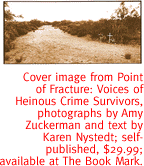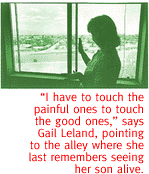

|

'Point Of Fracture' Gives A Powerful Public Voice To The Forgotten Criminal Element: Victims' Families.
By Margaret Regan
HALF A DOZEN years ago, the photographer Amy Zuckerman
found herself obsessed with the murder of a young Tucson man.
He had disappeared, and died, after the most mundane of errands:
a quick run to a fast-food joint late at night. Struck by the
randomness of his death, Zuckerman followed his case avidly, reading
as many newspapers as she could, watching all the TV reports.
And after some suspects were charged, she religiously attended
their trials.
 Day after day, seated in the same room with the man's family,
she listened to the testimony about how a beloved son came to
meet his death. But his family had no public voice in the matter;
indeed they were muzzled by police and lawyers who told them not
to jeopardize the case by talking to reporters. Zuckerman became
close to the family, and this new relationship eventually inspired
a multi-media art project about the aftermath of murder.
Day after day, seated in the same room with the man's family,
she listened to the testimony about how a beloved son came to
meet his death. But his family had no public voice in the matter;
indeed they were muzzled by police and lawyers who told them not
to jeopardize the case by talking to reporters. Zuckerman became
close to the family, and this new relationship eventually inspired
a multi-media art project about the aftermath of murder.
Part oral history, part photography, Zuckerman's Point of
Fracture: Voices of Heinous Crime Survivors is now on view
at the Tucson Museum of Art. The installation is in a basement
room painted entirely in black; 12 large black-and-white Zuckerman
photos are hung on the walls, lit from behind, like reliquaries
in a church. A continuing tape-recorded loop of plaintive voices
is piped into the somber room.
 Zuckerman shot photos of the families of some 15 different murder
victims here in Tucson, while her collaborator, writer Karen Nystedt,
interviewed them. (The pair also published a book of the same
name, including more photos and a fuller text than the exhibition.)
The voices heard in the installation are spliced from Nystedt's
interview tapes, and they mostly belong to the families left behind
by the dead, though a few are rendered by actors. The families
are by turns bitter and sorrowful; no one has ever really put
the deaths behind them. There's a disconsolate mother of a murdered
daughter who declares, "I know I can kill now." A grown
daughter regrets that she still has "50 miserable years"
to live without her beloved mother, whose death her husband learned
of on the 10 o'clock news. A heartbroken father declares that
if everyone could feel, even for minute, the kind of pain that
disabled him over the murder of his daughter, everyone would unquestionably
try to erase evil from the world.
Zuckerman shot photos of the families of some 15 different murder
victims here in Tucson, while her collaborator, writer Karen Nystedt,
interviewed them. (The pair also published a book of the same
name, including more photos and a fuller text than the exhibition.)
The voices heard in the installation are spliced from Nystedt's
interview tapes, and they mostly belong to the families left behind
by the dead, though a few are rendered by actors. The families
are by turns bitter and sorrowful; no one has ever really put
the deaths behind them. There's a disconsolate mother of a murdered
daughter who declares, "I know I can kill now." A grown
daughter regrets that she still has "50 miserable years"
to live without her beloved mother, whose death her husband learned
of on the 10 o'clock news. A heartbroken father declares that
if everyone could feel, even for minute, the kind of pain that
disabled him over the murder of his daughter, everyone would unquestionably
try to erase evil from the world.
Finally given a chance to be heard in public, their voices are
overwhelming, so much so that you feel compelled to sit down and
listen to them first, really listen, before you can bring yourself
to study the artwork on the wall. There are few portraits in the
pictures; instead Zuckerman has aimed for the telling object,
moodily conveyed. One of the most gripping has no people at all:
It's a lonely desert road that meanders off into the distance,
but the victims the picture commemorates never had a chance to
travel its full length. Two white crosses, planted among bouquets
of flowers, mark their point of death. In another picture, a pair
of boots stands in for a young man who is dead, and in still another,
a woman's hands finger the cremated remains of her loved one.
A home shrine connects thematically to the Latino religious works
Zuckerman has exhibited in the past. A Chinese-American family
constructed the shrine in the wake of a triple murder at their
grocery, which left two loved ones and an employee dead. Festooned
with flowers, fruit, electric candles and incense, the shrine
stands below formal portraits of the dead on a wall.
 Then, too, there are Zuckerman's sad images of children who learned
about death too young. A teenage girl hugs an old bouquet of flowers
from her father's grave. On the wall is a picture of her intact
family in happier times, dad, mom and toddler beaming innocently
out of the past. In another, a little girl barely past toddlerhood
clutches a picture marked "Mommy," at a rally. She's
too young yet to know what she's lost, but she will, one day.
Then, too, there are Zuckerman's sad images of children who learned
about death too young. A teenage girl hugs an old bouquet of flowers
from her father's grave. On the wall is a picture of her intact
family in happier times, dad, mom and toddler beaming innocently
out of the past. In another, a little girl barely past toddlerhood
clutches a picture marked "Mommy," at a rally. She's
too young yet to know what she's lost, but she will, one day.
Some of the pictures are meaningful only to people who have read
the book. For instance, the key to the strange dark picture of
a woman gesturing out a window to the bright desert is found in
the chapter called "It Was Just Routine." The woman
is pointing out her old house, the last place she saw her 14-year-old
son before he walked away into death.
This mournful show acknowledges the pain of the forgotten survivors,
as Zuckerman hoped it would, and rightly avoids the more usual
analysis of the criminals and their motives. The families' wounds
are raw and their stories are horrific; their sorrows endow her
pictures with a power they might not otherwise have. The show
is instructive for those of us who have never yet gotten that
dreaded phone call in the night, that slow walk of a policeman
up to the front door. But the wrenching emotions that the families
disclose are hardly surprising. They're about what you'd expect
of people who experience a sister's whole self truncated into
a pair of arms tossed in a trash bin, a mother bloodied, a son
reduced to bones in the desert. 
Point of Fracture: Voices of Heinous Crime Survivors
continues through Sunday, June 21, at the Tucson Museum of
Art, 140 N. Main Ave. Summer hours are 10 a.m. to 4 p.m. Tuesday
through Saturday, noon to 4 p.m. Sunday, and closed Monday. Admission
is $2 for adults, $1 for seniors and students, free for children.
Admission is free for everybody on Tuesdays. For more information,
call 624-2333.
|
 |





